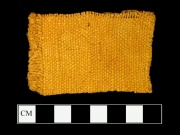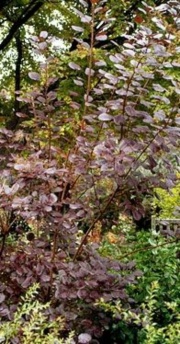Difference between revisions of "Young fustic"
m (Text replace - "\[http:\/\/cameo\.mfa\.org\/materials\/fullrecord\.asp\?name=([^\s]+)\s(.*)\]" to "$2") |
|||
| Line 4: | Line 4: | ||
A natural yellow dyestuff obtained from the wood of the smoketree, ''Cotinus coggygria'' (formerly ''Rhus cotinus''). This small tree, also called Venetian sumac, is native to southern Europe, the Middle East, India and China. The primary coloring compounds are fisetin and myricetin. Young fustic, also called fustet, has poor lightfastness. It was used for textiles and shading during the Middle Ages, but was rarely used after the 16th century. | A natural yellow dyestuff obtained from the wood of the smoketree, ''Cotinus coggygria'' (formerly ''Rhus cotinus''). This small tree, also called Venetian sumac, is native to southern Europe, the Middle East, India and China. The primary coloring compounds are fisetin and myricetin. Young fustic, also called fustet, has poor lightfastness. It was used for textiles and shading during the Middle Ages, but was rarely used after the 16th century. | ||
| − | (This is not the same dye as [[fustic|fustic]].) | + | (This is not the same dye as [[fustic|old fustic]].) |
== Synonyms and Related Terms == | == Synonyms and Related Terms == | ||
Revision as of 08:17, 19 June 2020
Description
A natural yellow dyestuff obtained from the wood of the smoketree, Cotinus coggygria (formerly Rhus cotinus). This small tree, also called Venetian sumac, is native to southern Europe, the Middle East, India and China. The primary coloring compounds are fisetin and myricetin. Young fustic, also called fustet, has poor lightfastness. It was used for textiles and shading during the Middle Ages, but was rarely used after the 16th century.
(This is not the same dye as old fustic.)
Synonyms and Related Terms
young fustik; Zante fustic; fustet; Hungarian yellow wood; Venetian sumach; fustelb (Fr.); Fisetholz (Deut.); scotano (It.); fustete (Esp.); fiset (Ned.); Natural Brown 1; CI 75620; fisetin; myriceti; Cotinus coggygria (European smoketree); Rhus cotinus
Other Properties
Fisetin is soluble in hot water, ethanol, alkali solutions.
Tree height = up to 5 m Bark = light gray-brown Foliage = purple color oval-shaped leaves.
| CAS | 528-48-3 |
|---|
Additional Information
° J.Hofenk-de Graaf, Natural Dyestuffs: Origin, Chemical Constitution, Identification, Central Research Laboratory for Objects of Art and Science, Amsterdam, September 1969.
Sources Checked for Data in Record
- Helmut Schweppe, Schweppe color collection index and information book
- G.S.Brady, Materials Handbook, McGraw-Hill Book Co., New York, 1971 Comment: p. 350
- Ralph Mayer, A Dictionary of Art Terms and Techniques, Harper and Row Publishers, New York, 1969 (also 1945 printing) Comment: Rhus cotimus
- Palmy Weigle, Ancient Dyes for Modern Weavers, Watson-Guptill Publications, New York, 1974 Comment: Rhus cotimus
- R.D. Harley, Artists' Pigments c. 1600-1835, Butterworth Scientific, London, 1982
- John and Margaret Cannon, Dye Plants and Dyeing, Herbert Press, London, 1994
- Encyclopedia Britannica, http://www.britannica.com Comment: "fustic." Encyclopædia Britannica. 2005. Encyclopædia Britannica Premium Service 7 Apr. 2005 .
- Website address 1 Comment: Virginia Tech Dencrology website at www.fw.vt.edu/dendro/dendrology/main.htm (accessed Oct. 3, 2005)
- F. Crace-Calvert, Dyeing and Calico Printing, Palmer & Howe, London, 1876
- Colour Index International online at www.colour-index.org
- Judith Hofenk-de Graaff, Natural Dyestuffs: Origin, Chemical Constitution, Identification, Central Research Laboratory for Objects of Art and Science, Amsterdam, 1969
- Wikipedia, the free encyclopedia, at http://www.wikipedia.com Comment: http://en.wikipedia.org/wiki/Smoketree (Accessed Oct. 3, 2005)
- Art and Architecture Thesaurus Online, http://www.getty.edu/research/tools/vocabulary/aat/, J. Paul Getty Trust, Los Angeles, 2000

